Attached files
| file | filename |
|---|---|
| EX-99.1 - EX-99.1 - AveXis, Inc. | a17-8445_1ex99d1.htm |
| 8-K - 8-K - AveXis, Inc. | a17-8445_18k.htm |
Exhibit 99.2
March 16, 2017 AVXS-101 Topline Phase 1 Clinical Trial Results Fourth Quarter and Full Year 2016 Financial and Operating Results
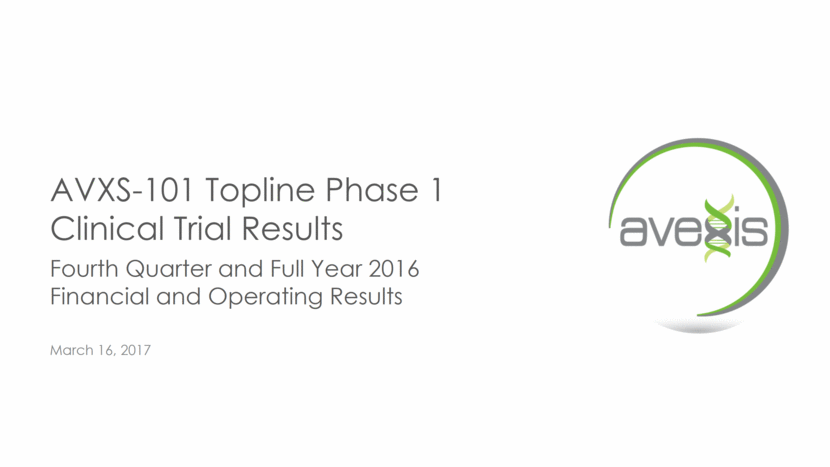
2 Forward-Looking Statements This presentation contains forward-looking statements, including statements about: the timing, progress and results of preclinical studies and clinical trials for AVXS-101, including statements regarding the timing of initiation of studies or trials and related preparatory work, our expectations regarding timing for meetings with regulatory agencies, our manufacturing strategy and developments, key regulatory and development milestones and our research and development programs. These statements involve substantial known and unknown risks, uncertainties and other factors that may cause our actual results, levels of activity, performance or achievements to be materially different from the information expressed or implied by these forward-looking statements. We may not actually achieve the plans, intentions or expectations disclosed in our forward-looking statements, and you should not place undue reliance on our forward-looking statements. Actual results or events could differ materially from the plans, intentions and expectations disclosed in the forward-looking statements we make. The forward-looking statements in this presentation represent our views as of the date of this presentation. We anticipate that subsequent events and developments will cause our views to change. However, while we may elect to update these forward-looking statements at some point in the future, we have no current intention of doing so except to the extent required by applicable law. You should, therefore, not rely on these forward-looking statements as representing our views as of any date subsequent to the date of this presentation. Disclaimers
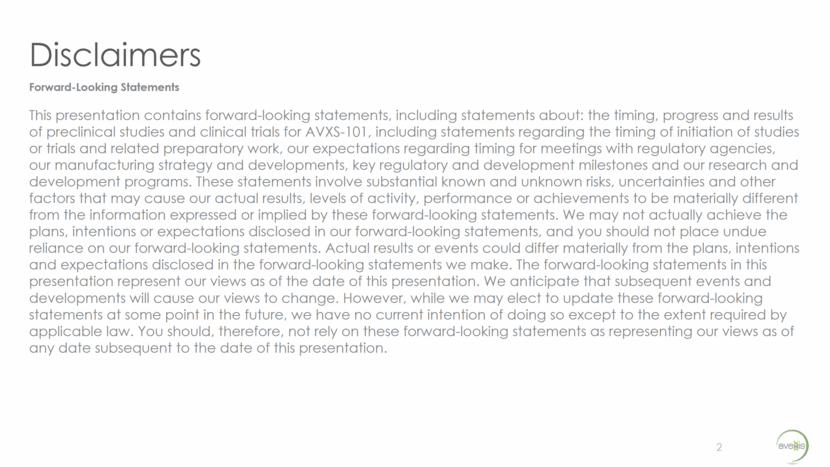
Our Strategy 3 Build pipeline of gene therapy treatments beyond SMA Expand development of AVXS-101 into SMA Type 2 Establish foundational presence in SMA Type 1 Vision: Leader in rare and life-threatening neurological genetic diseases Strategic Focus & Investment Time
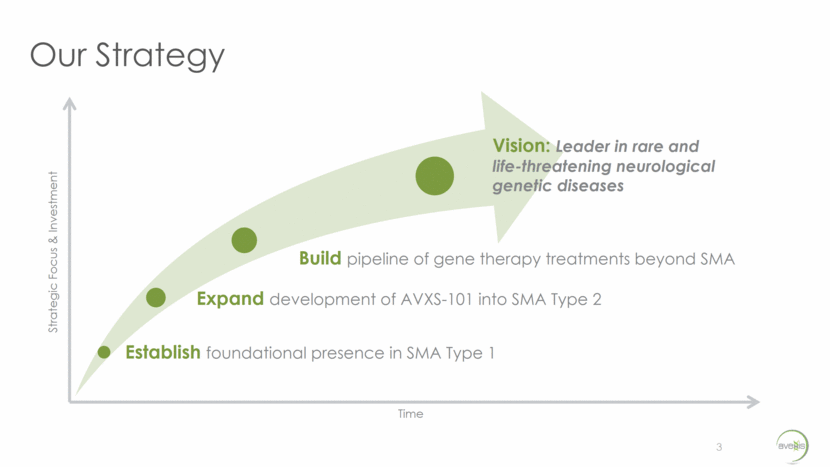
Overview of SMA 4 SMA is a devastating orphan disease that results in motor neuron loss and progressive weakness; it is the most common genetic cause of infant death Incidence: ~1 in 10,000 live births Caused by reduced SMN (survival motor neuron) protein levels from loss of/defective SMN1 gene SMA divided into sub-categories, Type 1- 4, with Type 1 being most severe Severity correlates with # of copies of SMN2 backup gene
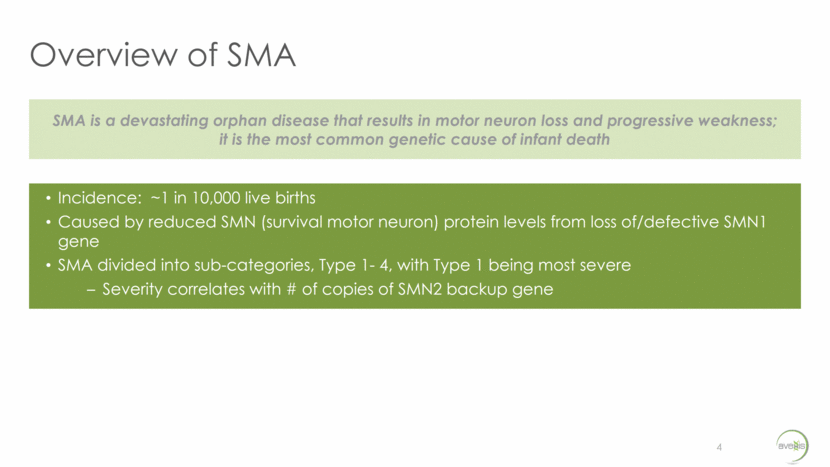
SMA Types: A Devastating Disease 5 TYPE 1 TYPE 2 TYPE 3 TYPE 4 SMN2 Copy Number Two Three or Four Three or Four Four to Eight Onset Before 6 Months 6-18 Months Early childhood to early adulthood (juvenile) Adulthood (20s-30s) usually after 30 Incidence per Live Birth Approximately 60% Approximately 27% Approximately 13% Uncommon; limited information available Developmental Milestones Will never be able to sit without support Difficulty breathing & swallowing Can’t crawl/will never walk Will never be able to walk or stand without support Stand alone and walk but may lose ability to walk in 30s-40s Stand alone and walk but may lose ability to walk in 30s-40s (Same as Type 3) Survival <10% Event free* by two years of age 68% alive at age 25 Normal Normal *Event = Death or >16-hr/day ventilation continuously for > 2 wks, in the absence of an acute reversible illness
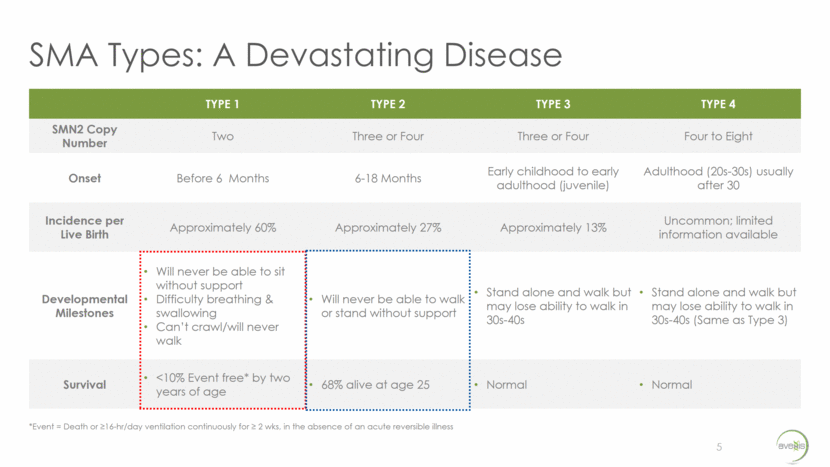
Natural History of SMA Type 1 “floppy baby” syndrome muscle weakness (legs more than arms) poor head control belly breathing bulbar muscle weakness (weak cry, difficulty swallowing, aspiration) will never sit unsupported loss of motor function: NeuroNEXT -- CHOP INTEND decrease of 10.5 points/yr. PNCR -- CHOP INTEND decrease of 1.27 points/yr. % Event-Free Survival* Age (mos.) PNCR (Finkel) NeuroNEXT (Kolb) *Survival for Finkel1 = no death, or no need for >16-hr/day ventilation continuously for > 2 weeks, in the absence of an acute reversible illness; n = 23 (2 copies of SMN2) Survival for Kolb2 = no death, or no tracheostomy; n = 20 75% survival 8.1 mos 50% survival 10.5 mos 25% survival 13.6 mos 8% survival 20 mos Holds head steady alone; brings hands to mouth Rolls over in both directions Sits alone; crawls Cruises; may stand alone Walks alone; may run and walk up stairs; eats with a spoon Climbs furniture alone; kicks and throws a ball Onset of SMA Type 1 by 6 months Symptoms may present More than 90% of SMA Type 1 patients will not survive or will need permanent ventilation support by age 2 6 Milestone for a healthy infant SMA Type 1 survival rates per Finkel1 50% survival 8 mos SMA Type 1 survival rate per Kolb2 0 25 50 75 100 0 2 4 6 8 10 12 14 16 18 20 22 24
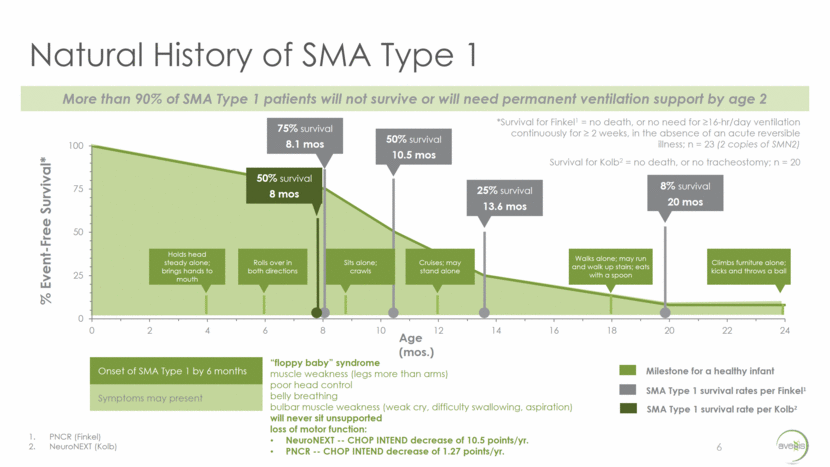
AVXS-101 Targets the Primary SMN Gene 7 NORMAL INDIVIDUAL SMA-AFFLICTED INDIVIDUAL SMA-AFFLICTED INDIVIDUAL TREATED WITH AVXS-101 SMN Genes SMN Protein SMN1 Primary SMN2 Back up SMN Genes SMN Protein SMN1 SMN2 Back up SMN Genes SMN Protein SMN1 SMN2 Back up AVXS-101 Primary Functional SMN Protein Not-functional SMN Protein
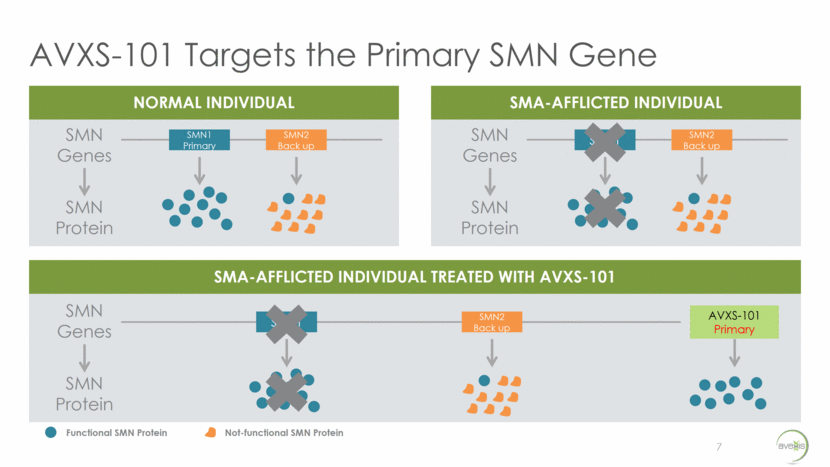
Our Solution: AVXS-101 An Innovative Treatment Approach for SMA 8 scAAV ITR Continuous Promoter Human SMN Transgene scAAV ITR KEY COMPONENTS PURPOSE Recombinant AAV9 Capsid Shell Ability to deliver across the blood brain barrier (BBB) and into the spinal cord - Avoids the need for intrathecal delivery when treating infants Non-replicating virus does not modify the existing DNA of the patient. scAAV ITR (Self-complementary DNA technology) Enables rapid onset of effect which is key in a quickly deteriorating population Continuous Promoter Activates the transgene to allow for continuous and sustained SMN expression Human SMN Transgene Full copy of a stable, functioning SMN gene that is introduced into the cell’s nucleus Recombinant AAV9 Capsid Shell Rendering adapted from DiMattia et al. Structural Insight into the Unique Properties of Adeno-Associated Virus Serotype 9. J. Virol. June 2012. Gene therapy is the right approach for SMA: Monogenic mutation that drives the pathology
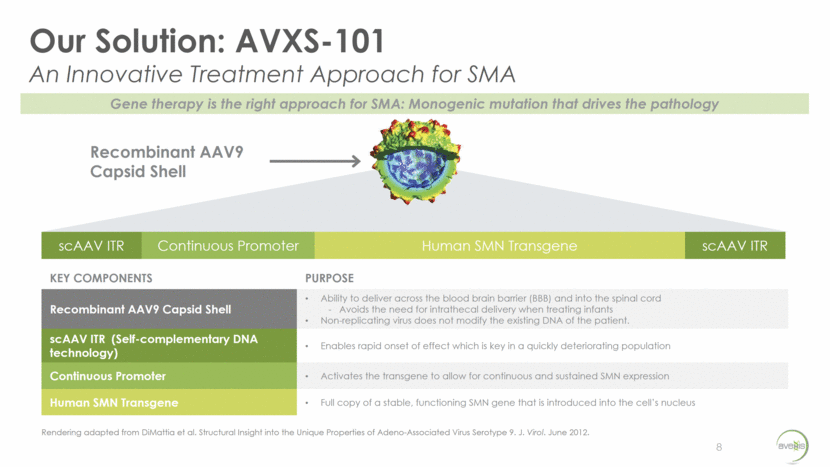
Children with SMA Type 1 Do Not Reach Any Major Motor Milestones Retrospective Study from large multi-center datasets (US and EU) Patients (n=33) have genetically confirmed homozygous deletion of exon 7 in SMN1 gene; categorized according to Dubowitz’s decimal classification (confirmation of SMN1 status and clinical observations) Study visits at baseline, every 2-3 months until the age of 12 months, and every 6 months thereafter, when possible Hammersmith Infant Neurological Examination (HINE) used to assess intermediate steps leading to full achievement of milestones DESIGN Prolongation of survival with supportive care does not impact achievement of motor milestones in SMA Type 1 infants SMA Type 1 infants with symptom onset <6 months: Will not reach any major motor milestones, such as sitting, crawling, standing, and walking Any early intermediate milestones in 1B patients will be quickly lost The highest milestone achieved is seen in the child’s first visit followed by a rapid decline Any improvement or achievement of milestones not usually achieved in a child with SMA Type 1 in a drug intervention trial can be attributed to the drug and not due to survival or enhanced standard of care CONCLUSIONS Developmental Milestones in Type 1 Spinal Muscular Atrophy De Sanctis et al. Neuromuscular Disorders, Nov-2016 9
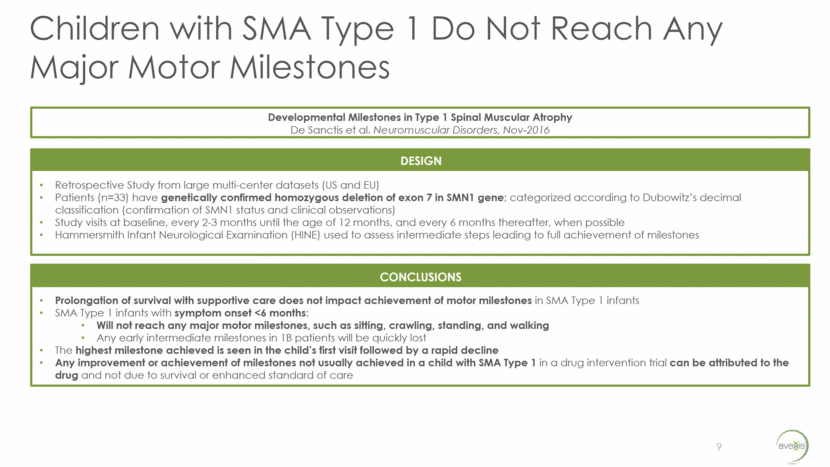
Clinical Study Closeout – January 20, 2017 10 TRIAL OVERVIEW Route of Administration One-time intravenous infusion through peripheral limb vein Prednisolone 1 mg/kg 1 day Pre-GT Trial Design Open-label, dose-escalation Principal Investigator Jerry R. Mendell, M.D. AVXS-101 PHASE 1 TRIAL OVERVIEW – SMA TYPE 1 Study Site OBJECTIVES Primary Safety and Tolerability Secondary Time from birth until death or time to >16-hour ventilation continuously for >2 weeks in the absence of an acute reversible illness or perioperatively Video confirmed achievement of ability to sit unassisted* Additional CHOP INTEND Bayley Motor Scales of Infant/Toddler development – Gross Motor OBJECTIVES OBJECTIVES Inclusion 9 months of age / 6 months of age¹ and younger at day of vector infusion with SMA Type 1 as defined by the following features: Bi-allelic SMN1 gene deletion or point mutations All enrolled patients carry bi-allelic SMN1 deletions, confirmed by independent laboratory 2 copies of SMN2 Onset of disease at birth to 6 months of age Hypotonia by clinical evaluation with delay in motor skills, poor head control, round shoulder posture and hypermobility of joints Exclusion Active viral infection (includes HIV or serology positive for hepatitis B or C) Use of invasive ventilatory support (tracheotomy)* or pulse oximetry <95% saturation Patients with Anti-AAV9 antibody titers >1:50 as determined by ELISA binding immunoassay Abnormal laboratory values considered to be clinically significant Patients with the c.859G>C mutation in SMN2 exon 7 (predicted mild phenotype)2 Key Enrollment Criteria Clinicaltrials.gov Identifier = NCT02122952 ¹ Inclusion criteria was 9 months of age and younger for the first nine patients. 6 months of age and younger for the last six patients. 2 Exclusion criteria related to c.859G>C was confirmed for all patients by an independent laboratory. *Patients may be put on non-invasive ventilatory support (BiPAP) for <16 hours/day at discretion of their physician or study staff. *key developmental milestone achievements assessed and adjudicated by external independent reviewer
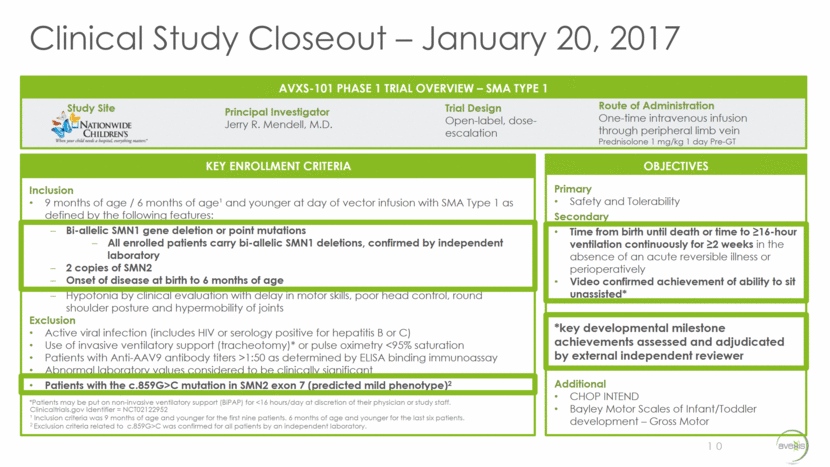
Event-Free Survival Data – January 20, 2017 * A month is defined as 30 days Cohort 1 6.7E13 vg/kg Cohort 2 2.0E14 vg/kg PNCR (Finkel) 2014 Natural History Study: 75% event-free 50% event-free 25% event-free 8% event-free 11 Age at Last Follow-up Cohort 1*: 30.8 months (median) 30.4 months (mean) Cohort 2*: 20.2 months (median) 20.7 months (mean) *reflects age at Last Trial Visit or most recent pulmonary assessment, E.02’s age at Pulmonary Event Day of Gene Transfer Last Trial Visit – Age Fixed Pulmonary Event – Age Fixed SURVIVAL DATA 9/9 reached 20 mo. event-free (8% PNCR) 15/15 reached 13.6 mo. event-free (25% PNCR) 15/15 reached 10.5 mo. event-free (50% PNCR) 15/15 reached 8.1 mo. event-free (75% PNCR) 0 1 2 3 4 5 6 7 8 9 10 11 12 13 14 15 16 17 18 19 20 21 22 23 24 25 26 27 28 29 30 31 32 Age (months*)
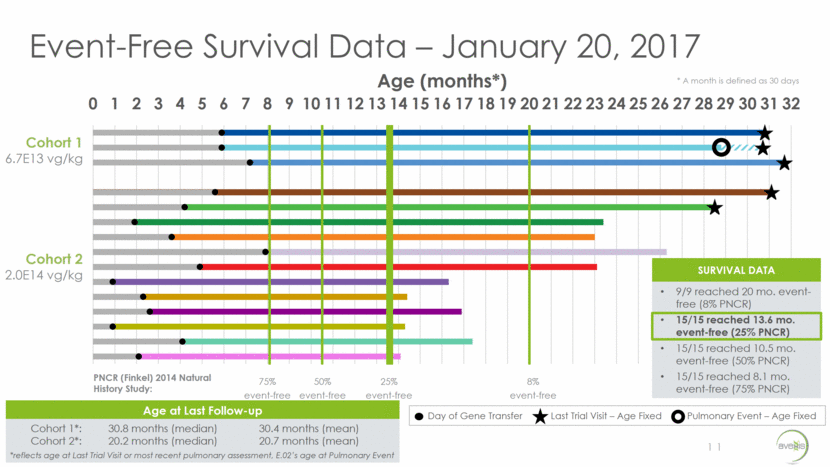
CHOP INTEND vs. Age – January 20, 2017 12 COHORT 1 (n=3) Baseline Age (months): 5.9 [median], 6.3 [mean] Current Age (months): 30.8 [median], 30.4 [mean] Mean CHOP INTEND Increase: 7.7 points COHORT 2 (n=12) Baseline Age (months): 3.1 [median], 3.4 [mean] Current Age (months): 20.2 [median], 20.7 [mean] Mean CHOP INTEND Increase: 24.7 points Dashed line denotes missed or partial assessments Rapid Response in Cohort 2 CHOP INTEND Increase at Month 1: 9.8 [mean] CHOP INTEND Increase at Month 3: 15.4 [mean] Early intervention and dose appear to affect response 0 10 20 30 40 50 60 0 3 6 9 12 15 18 21 24 27 30 CHOP INTEND Scores Age (months) 1 month = 30 days E.01 E.02 E.03 E.04 E.05 E.06 E.07 E.08 E.09 E.10 E.11 E.12 E.13 E.14 E.15
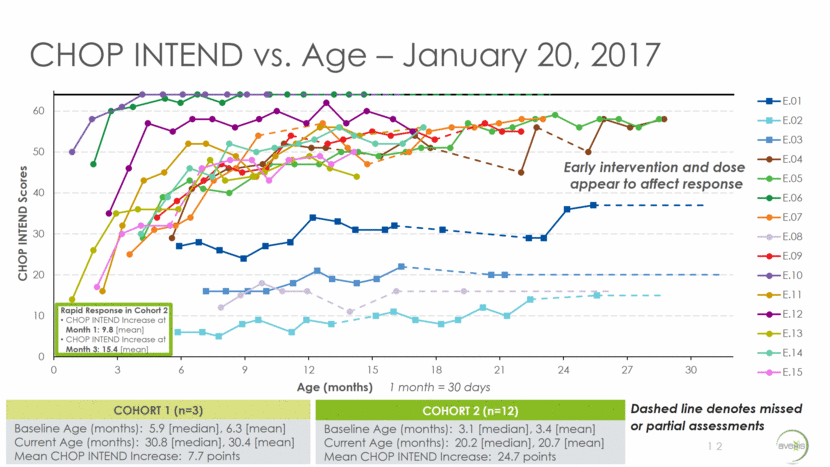
Safety Data – January 20, 2017 SAFETY AND TOLERABILITY OBSERVATIONS No new treatment-related SAEs or AEs observed As previously reported, a total of 5 treatment-related AEs in 4 patients have been reported following monitoring and source verification Treatment-related SAEs and AEs were clinically asymptomatic elevated liver function enzymes (LFEs) assessed under CTCAE on the basis on laboratory values and resolved with prednisolone treatment* 2 were SAEs experienced by 2 patients 3 were AEs experienced by 2 patients A total 256 AEs (5 treatment-related AEs and 251 non-treatment related AEs) have been reported following monitoring and source verification 52 SAEs and 204 non-serious AEs 65 AEs have occurred since September 15, 2016 10 disease-related SAEs in 3 patients have occurred since September 15, 2016 AVXS-101 appears to have a favorable safety profile and appears to be generally well-tolerated in patients studied to date 13 *No drug-induced liver injury (DILI) as defined by Hy’s Law
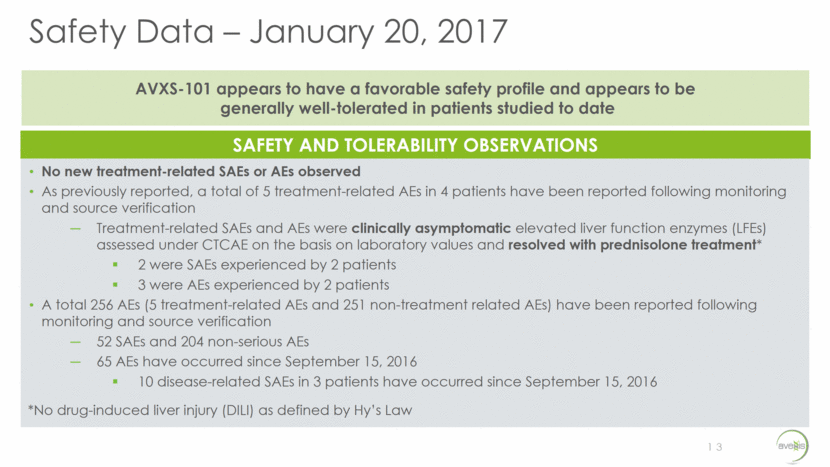
Children with SMA Type 1 Never Sit Unassisted 14 Disease Characteristics Disease onset <6 months Hypotonia and weakness Bulbar muscle weakness Difficulty breathing and swallowing Inexorable progression to nutritional failure Inexorable progression to respiratory failure Developmental Milestone Prognosis Progressive decline in motor function soon after birth Rapid loss of any early milestones (e.g. head control, hands to mouth) Will never be able to sit unassisted Will never be able to roll Will never be able to crawl, stand, or walk The Natural History of SMA Type 1 is marked by the inability to achieve or maintain developmental milestones
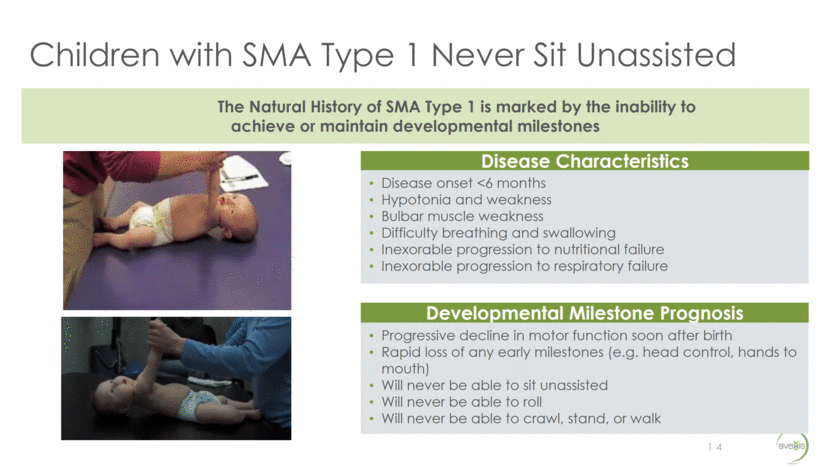
Motor Milestone Achievement Assessed and Adjudicated by Independent External Reviewer – January 20, 2017 15 Cohort 2 2.0e14 vg/kg Age at GT (mos) Motor Milestone Achievement Brings hand to mouth Head control Partial Rolla Rollb Sitting with assistance Sitting Unassisted > 5 secondsc > 10 secondsd > 30 secondse E.04 6 E.05 4 E.06 2 E.07 4 E.08 8 E.09 5 E.10 1 E.11 2 E.12 3 E.13 1 E.14 4 E.15 2 a a a a a a a a a a a a a a a a a a a a a a a a a a a a a a a a a a a a a a a a a a a a a a a a a a a a a a a a a a a a a a a a a a a a a a a a a Two children stand with support, and stand and walk independently Bayley Scales of Infant and Toddler Development, item #20, rolls a minimum 180o from back in only one direction. Bayley Scales of Infant and Toddler Development, item #20, rolls a minimum 180o from back to both left and right. Sitting unassisted for >5 seconds is in accordance with the criteria of item 22 in the Bayley Scales of Infant and Toddler Development – gross motor subtest and surpasses the three second count used as a basis for sitting (test item 1) in the Hammersmith Functional Motor Scale – Expanded for SMA (HFMSE). Sitting unassisted for >10 seconds is in accordance with the criteria in the World Health Organization – MultiCentre Growth Reference Study. Sitting unassisted for >30 seconds defines functional independent sitting and is in accordance with the criteria of item 26 in the Bayley Scales of Infant and Toddler Development – gross motor subtest.
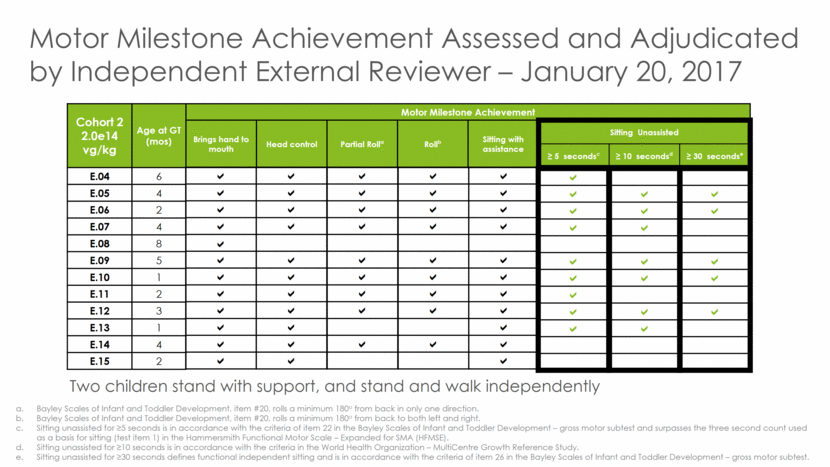
Financial Position (dollars in millions) 16 Cash and cash equivalents of $240.4 million as of December 31, 2016 Three months ended 12/31/16 Three months ended 12/31/15 R&D Expense $18.3 $8.7 G&A Expense $7.2 $4.4 Net Loss $25.4 $13.2
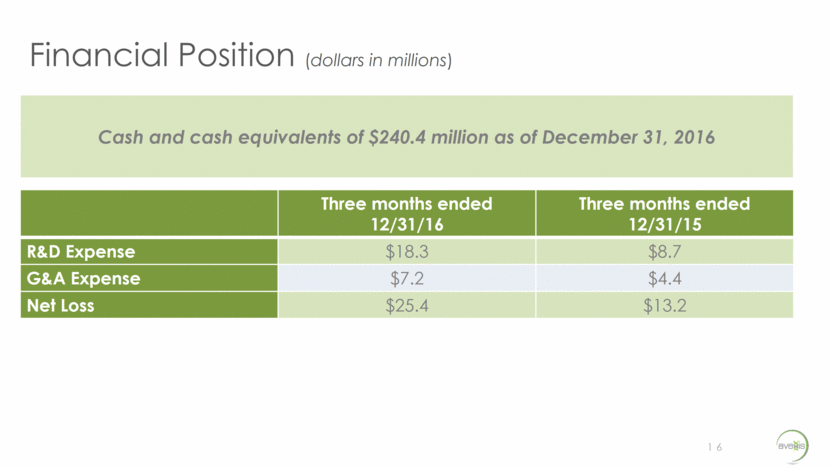
Company Milestones 17 Type 1 Program Type 2 Program 2017 Manufacturing Q2 2017: Initiate SMA Type 1 pivotal trial in U.S.* Q1 2017: Provide update on EU regulatory pathway and trial design feedback Q2 2017: Anticipated update/minutes from CMC Type B meeting Q1 2017: 13.6 months of data for all patients in the Phase 1 trial Q2 2017: Initiate Phase 1 safety and dosing study in SMA Type 2 via intrathecal (IT) delivery* Q2/Q3 2017: End-of-Phase 1 meeting with FDA Q2/Q3 2017: Conduct a comprehensive clinical program review with EMA 2H 2017: Initiate SMA Type 1 pivotal trial in EU* *Assumes positive outcome of CMC Type B meeting
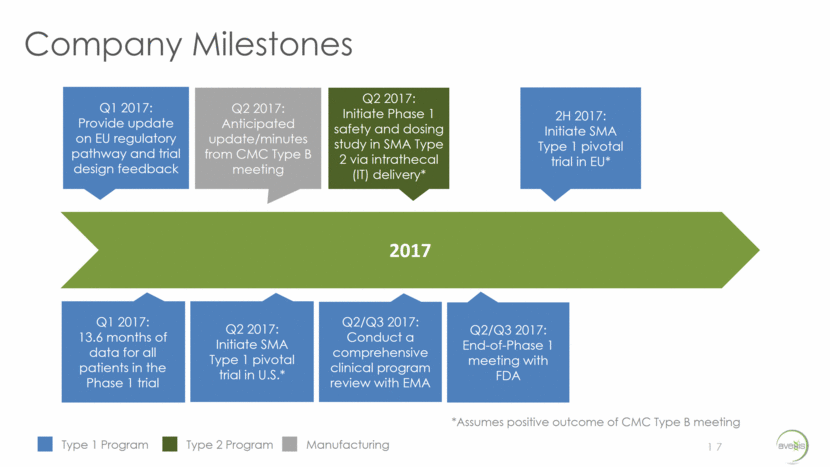
Thank You

